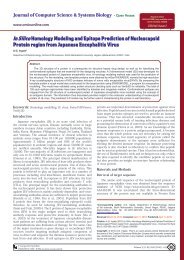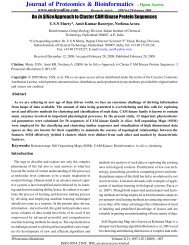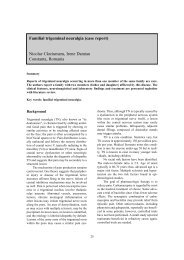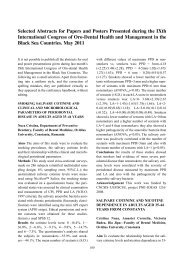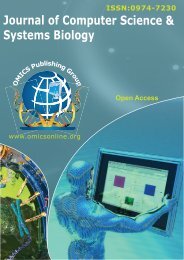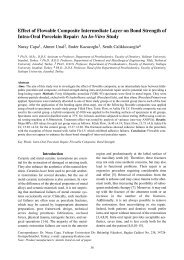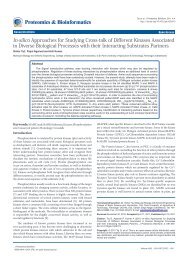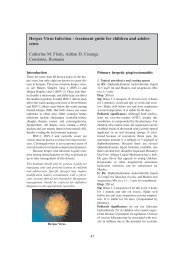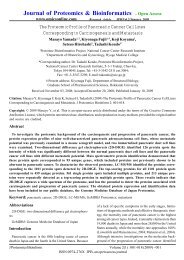Journal of Proteomics & Bioinformatics - Open Access
Journal of Proteomics & Bioinformatics - Open Access
Journal of Proteomics & Bioinformatics - Open Access
You also want an ePaper? Increase the reach of your titles
YUMPU automatically turns print PDFs into web optimized ePapers that Google loves.
<strong>Journal</strong> <strong>of</strong> <strong>Proteomics</strong> & <strong>Bioinformatics</strong> - <strong>Open</strong> <strong>Access</strong>www.omicsonline.com Regular article JPB/Vol.1/April 2008tionnaire (McMonnies et al., 1986).Sample collection was performed in a clean ophthalmic consultingroom and the examining ophthalmologist wore sterile glovesin order to minimise contamination <strong>of</strong> test samples. In addition,negative control swabs were taken at the time and place <strong>of</strong> subjecttesting to confirm the lack <strong>of</strong> environmental contamination.After instillation <strong>of</strong> topical anaesthetic, the ocular specimen forprotein analysis was collected from the posterior lid margin andlower conjunctival sac using a sterile cotton swab (Bibby SterilinLtd., Stone, UK). The swab was immediately cut into a sterilelysing matrix extraction tube containing ceramic and silica beads(BIO 101 Anachem, UK) and 1ml <strong>of</strong> sodium phosphate buffer usingsterile scissors.Protein extraction and quantificationThe extraction tube containing the swab was processedusing a FastPrep Instrument (Anachem, UK) at a preset speed <strong>of</strong>6.0 for 30 s with a 2 min resting period on ice before the procedurewas repeated. The sample was the centrifuged for 30 minutes at25,000 g to remove cellular debris, the supernatant was decantedand stored frozen at –70°C until required. The total soluble proteincontent was measured using the Bradford assay (Bradford,1976).One dimensional gel electrophoeresisAn aliquot <strong>of</strong> the supernatant (10 ìL) was added to 10ìL Tris-Glycine SDS sample loading buffer (Invitrogen,Renfrewshire, UK) and boiled for 5 min. The sample (20 ìL; 50 ìgtotal protein) was loaded onto a 1 mm thick Nu-Page 4-12 % Bis-Tris gel (Invitrogen, Renfrewshire, UK). SeeBlue Plus 2(Invitrogen, Renfrewshire, UK) was used as a protein molecularmass marker. The gel was electrophoresed, using MES SDS runningbuffer, in an X-Cell II mini gel system (Invitrogen, Renfrewshire,UK) at 200 V, 120 mA, 25 W per gel for 35 min. Proteins werevisualised using SimplyBlue Safestain (Invitrogen,Renfrewshire, UK). The entire lane was excised from the gel andcut into 3 mm fractions.In-Gel Tryptic DigestionExcised gel fractions were washed overnight in 200 ìL<strong>of</strong> a 50% (v/v) methanol and 5% (v/v) acetic acid solution. Thesefractions were then dehydrated by incubation for 5 min in 200 ìLacetonitrile. 30 ìL <strong>of</strong> 10 mM ditiothreitol was added and incubatedfor 30 mins at room temperature, followed by the addition <strong>of</strong>30 ìL <strong>of</strong> 100 mM iodoacetamide for 30 min. 200 ìL acetonitrile wasadded and incubated for a further 5 min. Rehydration <strong>of</strong> gel fractionswas carried out in 200 ìL <strong>of</strong> 100 mM NH 4HCO 3, pH 7.8 for 10min at room temperature. Gel fractions were dehydrated as aboveusingacetonitrile and then dried in a rotary evaporator. 30 ?L <strong>of</strong>20 ng/ìL trypsin in 50 mM NH 4HCO 3, pH 7.8 was added to eachsample and incubated overnight at 37°C. 30 ìL <strong>of</strong> 50 mM NH 4HCO 3was added to the samples and incubated for 10 min. The supernatantwas subsequently recovered into microcentrifuge tubes andtwo further peptide extractions from these gel pieces were carriedout with addition <strong>of</strong> 30 ìL 50% (v/v acetonitrile and 5% (v/v)formic acid) for 10 min. Peptide-containing liquid fractions werepooled, dried under vacuum and re-suspended in 20 µL 0.1%formic acid in 2% acetonitrile prior to storage at -70?C until required.LC-MS AnalysisMass spectrometry was performed using a 3200 Q-TRAPHybrid ESI Quadropole linear ion trap mass spectrometer, ESI-Qq-Qlinearion trap-MS/MS (Applied Biosystems/MDS SCIEX,Toronto, Canada) with a nanospray interface, coupled with anonline Ultimate 3000 nan<strong>of</strong>low liquid chromatography system(Dionex/LC Packings, Amsterdam, The Netherlands). A µ-Precolumn Cartridge (300 ìm × 5 mm, 5 ìm particle size) wasplaced prior to the C 18capillary column (75 µm × 150 mm, 3 µmparticle size) to enable desalting and filtering. Both columns containedthe reversed phase material PepMAP 100 (C 18silica-based)with a 100 Å pore size (Dionex/LC Packings). The elution buffersused in the gradient were Buffer A (0.1% formic acid in 2% acetonitrile)and Buffer B (0.1% formic acid in 80% acetonitrile). ThenanoLC gradient used was 60 min in length: 0 – 55% B in 45 min,10 min at 90% B followed by 5 min at 100% A. The flow rate <strong>of</strong> thegradient was 300 nLmin -1 . The detector mass range was set at400–1800 m/z. MS data acquisition was performed in positive ionmode. During MS acquisition peptides with 2+ and 3+ charge statewere selected for fragmentation.Database Searching, Protein Identification and PROVALT Analysis.Protein identification was carried out using an internalMASCOT server (version 1.9; Matrix Science, London, UK)searching against a human database extracted from the NCBI database(latest version at the time <strong>of</strong> processing). Peptide tolerancewas set at ± 1.2 Da with MS/MS tolerance set at ± 0.6 Da andthe search set to allow for 1 missed cleavage.Carbamidomethylation was set as a fixed modification and oxidation<strong>of</strong> methionine as a variable modification within the searchparameter settings. In order to expedite the curation <strong>of</strong> the identifiedprotein list from MASCOT, the result files were re-analysedagainst this extracted database using the heuristic method knownas the protein validation tool PROVALT (Weatherly et al., 2005).This automated program takes large proteomic MS datasets andreorganises them by taking multiple MASCOT results and identifyingthose peptides that match. Redundant peptides are removedand related peptides are grouped together associated with theirpredicted matching protein, thus, the program dramatically reducesthis portion <strong>of</strong> the curation process. For identificationpurposes the minimum peptide length was set at 6 amino acids,minimum peptide MOWSE score was set at 25 and the minimumhigh quality peptide MOWSE score was set at 40. PROVALT alsouses peptide matches from a random database (in this case theextracted human database was randomised) to calculate falsediscoveryrates (FDR) for protein identifications as previouslydescribed by Weatherly et al.(2005). Briefly, identifications fromsearching the normal and random databases are used to calculatethe FDRs and set score thresholds and thus identify as many‘actual’ proteins as possible while encountering a minimal number<strong>of</strong> false-positive protein identifications. Rather than calculate errorrates at the peptide level, the FDR calculations employed byPROVALT provide a reasonable balance between the number <strong>of</strong>correct and incorrect protein assignments. In this study the FDRwas set at 1%, meaning that 99% <strong>of</strong> the reported proteins identifiedshould be correct.<strong>Journal</strong> <strong>of</strong> <strong>Proteomics</strong> & <strong>Bioinformatics</strong> (JPB) Volume 1(1): 017-027(2008) -18ISSN:0974-276X JPB, an open access journal © 2008 OMICS Publishing Group



